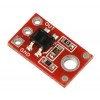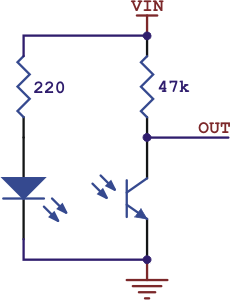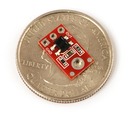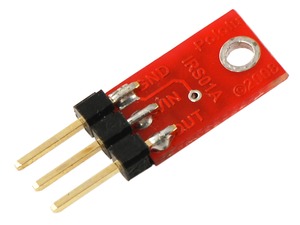- Out-of-Stock



QTR-1A Reflectance Sensor
QTR-1A Reflectance Sensor
The QTR-1A reflectance sensor carries a single infrared LED and phototransistor pair in an inexpensive, tiny 0.5" x 0.3" module that can be mounted almost anywhere and is great for edge detection and line following applications. The reflectance measurement is output as an analog voltage.
Note: The QTR-1A reflectance sensor requires an analog input to take readings. The similar QTR-1RC reflectance sensor is available with a digital I/O-compatible output.
 |
The Pololu QTR-1A reflectance sensor carries a single infrared LED and phototransistor pair. The phototransistor is connected to a pull-up resistor to form a voltage divider that produces an analog voltage output between 0 V and VIN (which is typically 5 V) as a function of the reflected IR. Lower output voltage is an indication of greater reflection.
The LED current-limiting resistor is set to deliver approximately 20-25 mA to the LED when VIN is 5 V. The current requirement can be met by some microcontroller I/O lines, allowing the sensor to be powered up and down through an I/O line to conserve power.
Because of its small size, multiple units can easily be arranged to fit various applications such as line sensing and proximity/edge detection. For a line sensor with eight of these units arranged in a row, please see the QTR-8A reflectance sensor array.
There are several ways you can interface with the QTR-1A output:
This last method will work if you are able to get high reflectance from your white surface as depicted in the left image, but will probably fail if you have a lower-reflectance signal profile like the one on the right.
|
|
Our Pololu AVR library provides functions that make it easy to use these sensors with our Orangutan robot controllers and other AVR-based controller boards such as Arduinos.
 |
This module has a single mounting hole intended for a #2 screw (not included); if this mounting hole is not needed, this portion of the PCB can be ground off to make the unit even smaller. The reflectance sensor ships with a 3-pin 0.1" header strip, which can be soldered in the conventional perpendicular orientation or parallel to the PCB, as shown below. You can also solder wires, such as ribbon cable, directly to the pads for the smallest installation.
 |
| An example of soldering header pins parallel to QTR-1A PCB for compact installation. |
|---|
 |
QTR-1RC Reflectance Sensor |
 |
Sharp GP2Y0A21YK0F Analog Distance Sensor 10-80cm |
 |
Pololu Carrier with Sharp GP2Y0D810Z0F Digital Distance Sensor 10cm |
No product available!
No product available!
A set of POD modules dedicated to the Raspberry Pi Zero and Zero 2W. Includes Zero POD Case, USB and HDMI expander module and LAN expander. Waveshare Zero POD KIT A
No product available!
No product available!
Starter kit with Raspberry Pi Zero 2 W and official accessories
No product available!
No product available!
No product available!
No product available!
No product available!
No product available!
No product available!
No product available!
ROSA3D filament made of high-quality PLA granules. 0.8 kg of filament with a diameter of 1.75 mm is wound on the spool. ROSA3D PLA Starter Rubin Red
No product available!
ODROID-HC2 is a mini PC with Samsung Exynos5422 Cortex-A15 2Ghz and Cortex-A7 Octa core CPUs
No product available!
No product available!
No product available!

QTR-1A Reflectance Sensor
